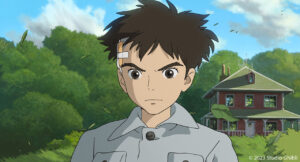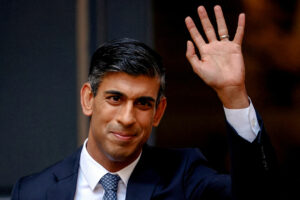A fantastical, dreamlike swan song

Movie ReviewThe Boy and the HeronDirected by Hayao Miyazaki
By Brontë H. Lacsamana, Reporter
IT IS impossible to watch this film without wondering why it came to exist. The great Hayao Miyazaki, the 82-year-old co-founder of the beloved animation company Studio Ghibli, came out of retirement yet again to deliver his “final” film, The Boy and the Heron.
Seven years after it was announced and a full 10 years after his 2013 magnum opus The Wind Rises, many now doubt if this is truly the end of his illustrious career, especially after he has claimed it was over several times before. But who can blame him? Animation is his life, and many artists are known for creating more personal yet complex works in their old age.
The Boy and the Heron’s original Japanese title, How Do You Live?, is taken from the 1937 novel that inspired it, only appearing in the film as a book that is left to the protagonist by his deceased mother. It also poses a question that perhaps Miyazaki himself is answering, or suggesting we answer on our own.
The film follows 12-year-old Mahito (voiced by Soma Santoki in Japanese, and Luca Padovan in the English dub), still devastated by the tragic death of his mother during World War II. His journey of acceptance is made difficult by his father moving on with his mother’s sister, as they relocate to her countryside estate. The titular heron (voiced by Masaki Suda in Japanese, and Robert Pattinson in the English dub) is an ominous gray nuisance inhabiting the grounds and serves as Mahito’s guide into a fantasy world.
This synopsis alone is exciting, but in the context of Miyazaki’s life and work a bit puzzling. It’s more dreamlike than what people might expect for an artist’s swan song. The Wind Rises seemed the perfect note to end on — a profound biopic-slash-self-portrait about a wartime engineer who grapples with the reality that makes his creations possible (no, it’s not Oppenheimer, but that would indeed make an excellent double feature).
Miyazaki is a legend in the industry but is also awfully cynical about the madness of this world being necessary to create the most astonishing things, be it stunning animation or weapons of war (see his musings in the documentary The Kingdom of Dreams and Madness, essential viewing material for Studio Ghibli fans). After churning out a 2013 masterpiece that sums up his perspective, think on why he comes back with a seemingly random fantasy adventure featuring a boy and a heron.
Except this new journey he brings us on isn’t as random as it appears. For one, it is also set in the period of Miyazaki’s boyhood during the war. It even features his lifelong fascination with flight, seen in the sheer number of birds in the film.
The Boy and the Heron can also be mistaken for a mere hodgepodge of Miyazaki tropes. Mahito’s coming-of-age fantasy adventure to find a parent mirrors Chihiro’s in Spirited Away. The cute, tiny proto-human blobs in the magical world look like the forest spirits in Princess Mononoke. Himi’s cottage is very similar to Howl’s in Howls Moving Castle, Himi herself mysteriously traversing time like Sophie does.
Of course, the self-reflecting narrative is akin to The Wind Rises. And the epic scenery of green, grassy fields under a picturesque blue sky evokes Nausicaa, Kiki, and, heck, much of the aesthetic that Studio Ghibli is now known for.
Still, it has its own unique additions, all spectacularly animated.
(Mild spoilers from this point on!)
Most visceral is the first sequence with Mahito running through a Tokyo being ravaged by flames. Most bizarre is the army of colorful parakeets that have overrun the tower’s secret world, all moving parts in a totalitarian system. The most thrilling is the ritual of tiny blobs floating up to the sky, being threatened by hungry pelicans, then eventually saved by a fire princess.
But the most poignant are Mahito’s surreal visions following the loss of his mother. They border on psychological horror — frogs that slowly climb all over his body, a sleeping woman on the sofa melting away into water, the falling of blocks causing the eventual crashing down of an imagined world.
It’s all impressionistic and dreamlike, somewhat underwhelming after all the narrative buildup. Admittedly, as a whole, it is far from Miyazaki’s best work. There is so much value hidden within it, though, in each painstakingly and intricately animated sequence. Here is a magical yet violent world that doesn’t completely make sense, but does if you dwell on how much of life is struggle, seen through the eyes of a mourning child not quite ready to move forward.
The Boy and the Heron is animation at its best, but also at its most expansive and overwhelming. It lacks the powerful, cohesive punch of The Wind Rises, which feels like the solid goodbye in a letter whereas this feels like the rambling, endearing P.S. trailing the end of it. (If Miyazaki comes up with another film, who knows how else this analogy may continue.)
At 82, he is creatively at his most restless yet preparing for the worst. Perhaps no one can truly carry on his legacy, the way he was afraid he couldn’t carry on the legacy of his good friend Isao Takahata (Grave of the Fireflies, The Tale of Princess Kaguya). It seems he has accepted that his own tower of blocks he has carefully built may also fall down with no one to stop it from happening.
In a world full of difficult truths that can easily crumble due to the folly of man, a chaotic ode to love, loss, and memory seems a most fitting goodbye.




